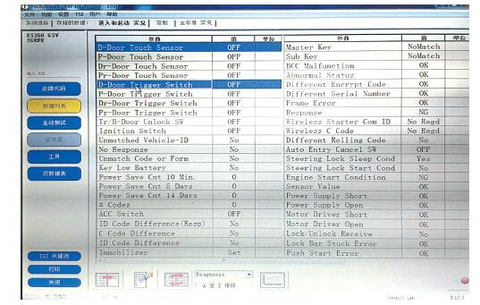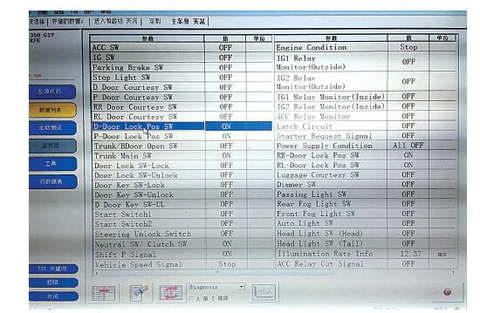[Repair Case] Lexus ES350 smart boarding system fails
Posted by Tony Brown on
Issue: The Lexus ES350 sedan has 136,000 miles and is fitted with one-key smart start and smart boarding functions. Customers say they can't utilize the smart car system normally.
Diagnosis: Start the vehicle without using the smart key to approach the ignition switch, indicating that the smart entry system is not turned off (can be set to turn off), turn the vehicle power mode to OFF state, press the smart key to lock and unlock Switch, it is discovered that the vehicle can be unlocked and locked normally, without any abnormalities, the vehicle will be unlocked. The vehicle could be locked properly when the lock button on the left front door handle was pressed, but it could not be unlocked normally. I tried yanking on the door handle many times but received no response. However, the vehicle may be unlocked and locked normally using the smart door handles on the other doors. The left front door handle's unlocking function is the only one that can't be utilized ordinarily.
Possible Causes:
① the smart door handle of the left front door; ② the wiring failure; ③ the authentication ECU failure; ④ the main body ECU; ⑤ the door lock failure.
First, you need to understand its working principle (as shown in Figure 1):
(1) The No. 1 terminal B of the smart door handle is the power supply, and the No. 7 terminal GND is the ground;
(2) The No. 3 terminal TSW1 of the certification ECU is the signal of the boarding lock switch;
(3) The No. 5 terminal SEL1 of the authentication ECU is a touch sensor (unlock) activation control signal;
(4) No. 22 terminal SEN1 of the authentication ECU is a touch sensor (unlock) detection signal;
(5) The No. 33 terminal CLG1 of the certification ECU is the sensor signal of the door electronic key oscillator (front left);
(6) The 34th terminal CG1B of the certification ECU is the sensor signal of the door electronic key oscillator (front left).
After that, verify that the key oscillator is in working order, run the authentication ECU tool, and run the key communication check. Turn off the power switch, and when the smart key is close to the left front door, a beep will sound to signal its proximity. The existence of the smart key has been recognized by the oscillator in the left front door, which has generated a detection region, as illustrated (in Figure 2, please ignore the original figure 2, thanks). Furthermore, when the smart key is near the left front door, the small red light on the smart key continues to blink. It also reveals that the front left door handle has recognized the presence of the smart key at this time.
Check whether the touch sensor (unlock) and the door lock switch are normal, and the data flow into the authentication ECU is shown in Figure 3.

The "D-Door Trigger Switch" left front door lock switch status switches from OFF to ON when the lock switch on the left front door handle is pressed, and the car is locked at the same time. Then I pulled the left front door handle and discovered that the data stream "D-Door TouchSensonr" may be used to turn on the left front door touch sensor. The unlocking and locking signals can be given back to the authentication ECU normally via the data stream feedback. Because its unlocking and locking signals can be fed back normally, the power supply and grounding of its own smart handle are unaffected. What is the problem that prevents the smart handle from being unlocked? At a stalemate, check the circuit diagram. There are two lines for the signal of the touch sensor, one is the detection signal line, and the other is the activation control signal line. Could it be that the signal feedback from the touch sensor is missing? Because there is no idea, I am going to measure these two sets of lines, connect the plug of the certified ECU, and measure the voltage of the 22nd terminal SEN1 of the plug E13 and the ground. The measured voltage is less than 1V when the door handle is touched. The detected voltage when you contact the door handle is 12V, which is normal. The voltage between the No. 5 terminal of the plug E13 and the ground should then be measured. Measure the voltage of the smart key while it is close to the left front door handle, which should be less than 1V, and when it is moved 5m away from the door handle, which should be more than 5V. The voltage at the terminals is 12V. There was nothing unusual about it. It was deadlocked again after checking here. The touch sensor, including the circuit, should not be a problem regardless of data flow feedback or terminal measurement. Is it possible that there are other flaws? Why, on the other hand, can the smart handle be used to lock the vehicle but not to open it? After relocking the vehicle, it was discovered that it was unable to enter the anti-theft system. After the vehicle was locked, the anti-theft indication light continued to flash. It should stay on for 20 seconds before flashing under normal situations. As a result, pay close attention to the door key switches on each of the four doors. The door key positions are not stuck after being locked, therefore go into the main body ECU and examine the status of the four door lock positions in detail, as illustrated in Figure 4.

The lock position of the left front door has been presented as ON after the door has been locked, despite the fact that all of the other doors' lock positions are OFF. Is it possible that the door lock position signal is inaccurate, preventing the smart entry system from unlocking? NS? Open the left rear door, let a person keep pushing the door switch, and then use the smart key to lock the vehicle, artificially flip the door key switch to keep the door lock position in ON In the state, I tried to use the smart handle to unlock the vehicle, but there was no reaction. When the door key switch was reinstalled, it was discovered that the door could be unlocked normally. As a result, emphasis on ensuring that the circuit of the left front door lock position is normal and that the circuit is free of problems after measurement. After further investigation, it was discovered that the left front door motor had been involved in a collision, causing the wire to loosen and the door lock position signal feedback to be erroneous. The fault is no longer present after reprocessing.
Summary: Because the door lock position is not thought to have a direct relationship with smart entry unlocking, and after the customer reported the problem, he diagnosed the problem without doing a thorough inspection of the car, which resulted in several detours.


